The peculiarities of the impact of disinformation on modern kazakh society
DOI:
https://doi.org/10.32523/3080-1702-2025-150-1-59-73Keywords:
media literacy, misinformation, critical thinking, fact-checking, information security, social media, KazakhstanAbstract
In today’s world, the flow of information is becoming increasingly intense, making the issue of misinformation dissemination particularly pressing. Fake news, manipulative narratives, and propaganda have a significant impact on public opinion, especially in the digital environment. Consequently, critical thinking and media literacy have become among the most essential competencies for every citizen.
The purpose of this study is to analyze the level of media literacy among Kazakhstan’s population, identify key factors influencing information perception, and determine the groups most vulnerable to misinformation. The paper explores the mechanisms of misinformation dissemination, its impact on different segments of society, and possible strategies for counteracting it.
The research methodology includes both quantitative and qualitative analyses. A nationwide survey of 1,000 respondents, along with expert interviews with media, communication, and education specialists, was conducted. The findings indicate that a significant portion of the population lacks a critical approach to assessing information from various sources, including social media. Young people and rural residents with limited educational and analytical resources are particularly susceptible to misinformation.
The study highlights the necessity of a comprehensive approach to media literacy development, which should encompass educational initiatives, increased transparency in information dissemination, and improvements in the quality of national media.
The practical significance of this study lies in the development of targeted measures aimed at fostering a critical attitude toward information, increasing trust in reliable sources, and creating a resilient media environment capable of withstanding manipulative information influences.








